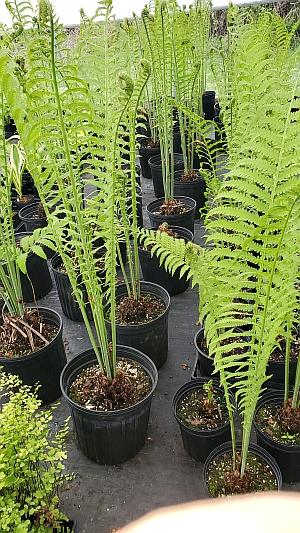View All Plants :: View All FERNS :: View All SHADE PERENNIALS

Matteuccia struthiopteris - Ostrich Fern Is tall, struthiopteris - Ostrich Fern from Quackin Grass Nursery
Matteuccia struthiopteris - Ostrich Fern Is tall, struthiopteris
Ostrich Fern
Plant Type:
FERNSMatteuccia struthiopteris - These are big plants in full 2-gallon pots. Ostrich Fern Is tall, stately and beautiful. This elegant species when content will spread into a large scale ground cover; a "grove" is mesmerizing; with a little imagination a colony may transport you to another much earlier age. It will tolerate more sun if planted on a low bank near water. Fiddleheads can be harvested and eaten; sauteed in a little butter they are delicious. Circumboreal nativity, in the New World Ostrich Fern idistribution s found in North Dakota, south to Nebraska, east to Virginia and north through all of New England and Canada. This is a plant that likes a cool environment. It will languish and die in the south. Part sun, preferably morning sun to dappled shade and open shade plant in fertile moist soil. Established potted fern from division.
Characteristics and Attributes for Matteuccia struthiopteris - Ostrich Fern Is tall, struthiopteris
Season of Interest (Foliage)
- Spring / Summer
Nature Attraction
- Deer Resistant
Light
- Morning Sun / Afternoon Shade
- Dappled Shade
- Shade
Attributes
- Wildlife Garden
- Edible
- Foliage
- Marginal
- Natural Garden
- Ground Cover
- Massing
- Cutting Garden
- Woodland
- Grouping
Growth Rate in the Garden
- Medium
Soil
- Moist
- Fertile
- Organic
Origins
- Circumboreal
Genus Overview: Ferns
Ferns. The easy, elegant and exceptional beauty of ferns cannot be understated. All ferns, beautiful as specimens unto themselves, are extraordinary in their simple ability to provide rich contrast to other companions wherever their requirements befit.
Habituated to so many environments many of the ferny pteridophytes – vascular plants that reproduce by spores, not seeds - are woodland denizens thriving on the cool, damp forest floor like the Christmas Fern, Polystichum acrostochoides with some preferring the wetter disposition of bogs, swamps, and stream banks such as Osmunda cinnamomea. Others will colonize gritty soils in shade or sun like the running Hay-scented fern, Dennstaedtia punctilobula and many among the Cheilanthes. Some are tough enough to grasp a foothold in the crack of a rock, these are lithophytic, as with Asplenium trichomanes. And some – most of these tropical in origin are truly epiphytic, clinging to tree bark as they unfurl their fronds from embryonic croziers to reach into the forest light such as the primitive looking Staghorn Fern, Platycerium bifurcatum or Rabbit-foot Fern, Davallia fejeensis .
And many have historic medicinal uses such as Maidenhair Fern, Adiantum pedtaum – this from medicinalherbinfor.org, “Expectorant, anti-rheumatic, demulcent, pectoral, refrigerant, tonic”... Native Americans throughout North America used maidenhair as a hair wash to make their hair shiny.” And in a more Bacchanalian use: as a flavoring in liquers.
There was probably something fern-like, an ancient ferny forebear(s) if you will, living during the Devonian some 60 to 70 million years ago. Ferns, some we still recognize today are descendents from an ancient order whose reign during the Carboniferous Age is legend, where giant horsetails and monstrous club mosses still populate the misty recesses of our dreams... and whose contemporary plundering by Homo sapiens in the vast burning of fossil fuels is altering our climate at such an alarming rate that more among the many are beginning to query as to the potential for another mass extinction – the closing chapter of another age, a blip in the larger context of perceived time. But I digress....
All our offerings are well-rooted pot grown divisions in 5 pint squares unless otherwise indicated. The quality we offer make them worth the money. We think you will agree.